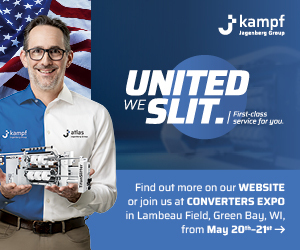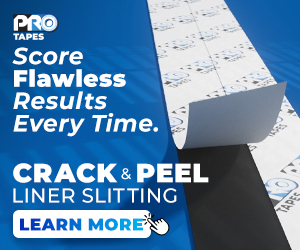Giving Adhesive Coating Its Due Respect
- Published: May 03, 2015, By Mark Miller
If you'd like to hear from Mark Miller's own lips rather than read his blog, titled "Adhesive Coating," click on his podcast below:
{mp3}adhesive-coating-voice{/mp3}
Adhesives are a coating in the converting world that do not get a lot of respect. However, when you look at the market of adhesive coating, the technology requirements and process expertise can be just as demanding as some higher tech type coatings in the electronics, optical and energy storage worlds. Considerations are similar, with an understanding of the economies playing a larger role.
So when adhesives are coated, the need for faster, wider and thinner coating technologies push process engineers to think about the limits of the coating window and the subsequent formulation chemistries. Let’s look at each of these items in turn -
FASTER. In coating systems, the typical bottleneck for increasing line speed and decreasing production cost, is the curing step. The methods of curing include oven drying, UV (light) energy and eBeam curing technology. This technologies each have their pros and cons, but how the adhesive chemistry is formulated plays a large part in this unit operation decision. Adhesives used to be coated out of solvent as the majority formulation technique. Other methods of formulation include water based solvation and 100% solids hot melt adhesive coating. In solvent and water based chemistries, an oven is required to dry off the solvent and potentially cure the adhesive. To coat faster, a longer oven is installed. For hot melt coating, either UV lights or eBeam may need to be installed. These energy sources may not be required if the hot melt does not have active end groups on the adhesive polymer, but then a cooling drum needs to be properly sized for the application. In addition to the curing step, if the coating technique is self-metering, then the coating system may also introduce a rate limiting step because of the need to formulate the fluid for fluid flow control with roll coating techniques.
WIDER. The width of coating has two major considerations – equipment manufacturing capabilities and substrate availability. In the converting world, “wide, fast and in one pass” is a common saying, but width may be counter productive for some applications. Where the converting of the jumbo rolls are difficult, coating the width of the final product may need to be considered as a viable option. These include systems where the coated product requires a dry edge on either side or where multiple handling can cause more rejected material. Dry edge considerations can be attacked with lane coating, but this adds one more factor of complexity to the coating process. And remember, every time the substrate is unwound and rewound, there is some waste.
THINNER. In order to reduce overall cost, one needs to consider labor and material costs. To reduce material costs, a process engineer looks at reduced scrap and reduced incoming raw material usage. Utilizing less adhesive for the same effect is a common approach. However, thinner coatings can run into a number of roadblocks. First and foremost, the thinner adhesive coating needs to perform at the level required for the customer’s use. After this hurdle is overcome, the process engineer and the formulation chemist need to work together to see how the adhesive polymer can be processed at a thinner coat weight without more stresses from the coating equipment being applied. Finally, the fluid flow phenomenon of the liquid itself needs to be considered as the liquid is processed through the equipment. Is there a lower limit for the internal strength of the adhesive polymer? This can only be determined through rheological analysis and pilot testing.
With these thoughts in mind, both chemists and process engineers can have a thoughtful response to the constant goal of coating products “wide, fast and in one pass.”











